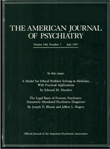Is the Course of Panic Disorder the Same in Women and Men?
Abstract
OBJECTIVE: Panic disorder with or without agoraphobia has a chronic relapsing course. Factors associated with poor outcome include early onset of illness and phobic avoidance. Several, but not all, authors have found a worse clinical course for women. Using observational, longitudinal data from the Harvard/Brown Anxiety Disorders Research Program, the authors analyzed remission and symptom recurrence rates in panic patients with respect to sex. METHOD: Male and female patients (N=412) in an episode of panic with or without agoraphobia were assessed by structured interview and prospectively followed for up to 5 years. Data on remission, symptom recurrence, and comorbid psychiatric conditions for each sex were compared. RESULTS: There were no significant differences between men and women in panic symptoms or level of severity at baseline. Women were more likely to have panic with agoraphobia (85% versus 75%), while men were more likely to have uncomplicated panic (25% versus 15%). The rates of remission for panic with or without agoraphobia at 5 years were equivalent in men and women (39%). Of the subjects who achieved remission, 25% of the women and 15% of the men reexperienced symptoms by 6 months. Recurrence of panic symptoms continued to be higher in women (82%) than men (51%) during the follow-up period and was not influenced by concurrent agoraphobia. CONCLUSIONS: This study extends previous findings by showing that not only are women more likely to have panic with concurrent agoraphobia, but they are more likely than men to suffer a recurrence of panic symptoms after remission of panic.



